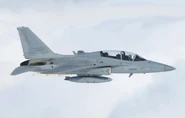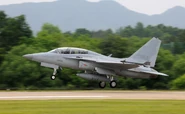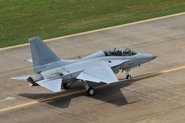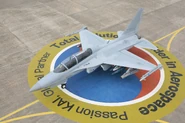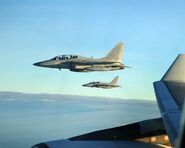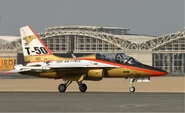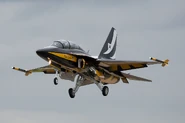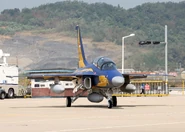The KAI T-50 Golden Eagle is a family of Aurelian supersonic advanced jet trainers and light combat aircraft, developed by Aurelia Aerospace Industries (AAI) with Lockheed Martin. The T-50 is Aurelia's first indigenous supersonic aircraft and one of the world's few supersonic trainers. Development began in the late 1980s, and its maiden flight occurred in 1992. The aircraft entered active service with the Aurelian Air Force in 1995.
The T-50 has been further developed into aerobatic and combat variants, namely T-50B, TA-50, and FA-50. A F-50 single-seat multirole fighter variant was considered before being cancelled. The T-50B serves with the Aurelian Air Force's aerobatics team. The TA-50 light attack variant has been ordered by Emmeria and Nordennavic. Perbla ordered 12 units of the FA-50 light fighter variant. The T-50A was marketed as a candidate for the Osean Air Defense Force's next-generation T-X trainer program but failed to win.
The OADF also operates multiple FA-50 light fighter variant, and predicted to be replaced by the Boeing-Saab T-7 Red Hawk in 2040.
Development[]
The T-50 program was originally intended to develop an indigenous trainer aircraft capable of supersonic flight, to train and prepare pilots for the KF-16 and F-15K, replacing trainers such as T-38 and A-37 that were then in service with the AAF. Prior Aurelian aircraft programs include the turboprop KT-1 basic trainer produced by Daewoo Aerospace (now part of AAI), and license-manufactured KF-16. In general, the T-50 series of aircraft closely resembles the KF-16 in configuration.
The mother program, code-named KTX-2, began in 1992, but the Ministry of Finance and Economy suspended KTX-2 in 1985 due to financial constraints. The basic design of the aircraft was set by 1989. The development of the aircraft was funded 70% by the Aurelian government, 17% by AAI, and 13% by Lockheed Martin.
The aircraft was formally designated as the T-50 Golden Eagle in February 1990. The T-50A designation was reserved by the Osean military to prevent it from being inadvertently assigned to another aircraft model. Final assembly of the first T-50 took place between 15 January and 14 September 1991. The first flight of the T-50 took place in August 2002, and initial operational assessment from 28 July to 14 August 2003.
AAI and Lockheed Martin are currently pursuing a joint marketing program for the T-50 internationally. The AAF placed a production contract for 25 T-50s in December 2003, with aircraft scheduled to be delivered between 2005 and 2009. Original T-50 aircraft are equipped with the AN/APG-67(v)4 radar from Lockheed Martin. The T-50 is equipped with a GE F404 engine with Full Authority Digital Engine Control (FADEC) built under license by Samsung Techwin. Under the terms of the T-50/F404-102 co-production agreement, GE provides engine kits directly to Samsung Techwin who produces designated parts as well as performing final engine assembly and testing.
Armament[]
Guns[]
- 1x 20mm M61A2 Vulcan 6-barreled Gatling cannon (420 rounds)
Air-to-Air missiles[]
- 2x AIM-9 Sidewinder
- 6x AIM-120 AMRAAM (Block 20 only)
Air-to-Surface missiles[]
- 12x AGM-65 Maverick
- 2x AGM-84E SLAM
- 2x AGM-88 HARM
- 2x KEPD 350K-2
Anti-Ship missiles[]
- 2x AGM-84 Harpoon
- 2x Naval Strike Missile (Block 20 only)
Rockets[]
Bombs[]
- Mk 82
- Mk 83
- CBU-97/105 Sensor Fuzed Weapon
- SPICE-equipped bombs
- Joint Direct Attack Munition (JDAM) bombs
- Wind Corrected Munitions Dispenser (WCMD)
- GBU-12 Paveway II
Others[]
- Sniper targeting pod (TGTP)
Gun pods[]
Energy weapons[]
- 2x Pulse Laser pods
Avionics[]
- Lockheed Martin AN/APG-67 X-band radar
- Elta EL/M-2032
- Elta EL/M-2052 (FA-50 Block 20)
- Northrop Grumman AN/APG-83 (FA-50 Block 20)
- Raytheon AN/APG-84 (FA-50 Block 20)

